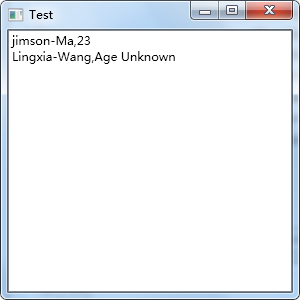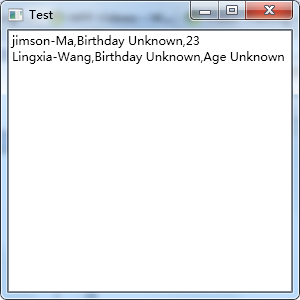上一节,提到了控制空值的TargetNullValue。本节介绍下另外两个跟绑定有关的关键字:StringFormat,FallbackValue。
StringFormat,顾名思义就是格式化字符串,在数据绑定的过程中,这个当然很重要了,谁不爱美阿。先看看上节的例子:
<
Window x:Class
=
"
WpfProject.Test
"
xmlns = " http://schemas.microsoft.com/winfx/2006/xaml/presentation "
xmlns:x = " http://schemas.microsoft.com/winfx/2006/xaml "
Title = " Test " Height = " 300 " Width = " 300 " Loaded = " Window_Loaded " >
< Grid >
< ListBox Name = " lbxPersons " >
< ListBox.ItemTemplate >
< DataTemplate >
< StackPanel Orientation = " Horizontal " >
< TextBlock Text = " {Binding FirstName} " Width = " 50 " />
< TextBlock Text = " {Binding LastName} " Width = " 50 " />
< TextBlock Text = " {Binding Age, TargetNullValue='Age Unknown'} " />
</ StackPanel >
</ DataTemplate >
</ ListBox.ItemTemplate >
</ ListBox >
</ Grid >
</ Window >
xmlns = " http://schemas.microsoft.com/winfx/2006/xaml/presentation "
xmlns:x = " http://schemas.microsoft.com/winfx/2006/xaml "
Title = " Test " Height = " 300 " Width = " 300 " Loaded = " Window_Loaded " >
< Grid >
< ListBox Name = " lbxPersons " >
< ListBox.ItemTemplate >
< DataTemplate >
< StackPanel Orientation = " Horizontal " >
< TextBlock Text = " {Binding FirstName} " Width = " 50 " />
< TextBlock Text = " {Binding LastName} " Width = " 50 " />
< TextBlock Text = " {Binding Age, TargetNullValue='Age Unknown'} " />
</ StackPanel >
</ DataTemplate >
</ ListBox.ItemTemplate >
</ ListBox >
</ Grid >
</ Window >
为了很好的显示我们所需要的数据,用了三个TextBlock,显得很啰嗦有很吃力,那么有没有更好的方法呢,用MultiBinding和StringFormat。

 代码
代码
<
Window x:Class
=
"
WpfProject.Test
"
xmlns = " http://schemas.microsoft.com/winfx/2006/xaml/presentation "
xmlns:x = " http://schemas.microsoft.com/winfx/2006/xaml "
xmlns:d = " clr-namespace:System.Windows.Data;assembly=PresentationFramework "
Title = " Test " Height = " 300 " Width = " 300 " Loaded = " Window_Loaded " >
< Grid >
< ListBox Name = " lbxPersons " >
< ListBox.ItemTemplate >
< DataTemplate >
< TextBlock >
< TextBlock.Text >
< MultiBinding StringFormat = " {}{0}-{1},{2} " >
< Binding Path = " FirstName " />
< Binding Path = " LastName " />
< Binding Path = " Age " TargetNullValue = ' Age Unknown ' />
</ MultiBinding >
</ TextBlock.Text >
</ TextBlock >
</ DataTemplate >
</ ListBox.ItemTemplate >
</ ListBox >
</ Grid >
</ Window >
xmlns = " http://schemas.microsoft.com/winfx/2006/xaml/presentation "
xmlns:x = " http://schemas.microsoft.com/winfx/2006/xaml "
xmlns:d = " clr-namespace:System.Windows.Data;assembly=PresentationFramework "
Title = " Test " Height = " 300 " Width = " 300 " Loaded = " Window_Loaded " >
< Grid >
< ListBox Name = " lbxPersons " >
< ListBox.ItemTemplate >
< DataTemplate >
< TextBlock >
< TextBlock.Text >
< MultiBinding StringFormat = " {}{0}-{1},{2} " >
< Binding Path = " FirstName " />
< Binding Path = " LastName " />
< Binding Path = " Age " TargetNullValue = ' Age Unknown ' />
</ MultiBinding >
</ TextBlock.Text >
</ TextBlock >
</ DataTemplate >
</ ListBox.ItemTemplate >
</ ListBox >
</ Grid >
</ Window >

FallbackValue设置邦定不存在时显示的信息。还是上面的例子,Person类里不存在Birthday属性,我们在绑定里添加,让它显示不存在。

 代码
代码
<
Window x:Class
=
"
WpfProject.Test
"
xmlns = " http://schemas.microsoft.com/winfx/2006/xaml/presentation "
xmlns:x = " http://schemas.microsoft.com/winfx/2006/xaml "
Title = " Test " Height = " 300 " Width = " 300 " Loaded = " Window_Loaded " >
< Grid >
< ListBox Name = " lbxPersons " >
< ListBox.ItemTemplate >
< DataTemplate >
< TextBlock >
< TextBlock.Text >
< MultiBinding StringFormat = " {}{0}-{1},{3},{2} " >
< Binding Path = " FirstName " />
< Binding Path = " LastName " />
< Binding Path = " Age " TargetNullValue = ' Age Unknown ' />
< Binding Path = " Birthday " FallbackValue = ' Birthday Unknown ' />
</ MultiBinding >
</ TextBlock.Text >
</ TextBlock >
</ DataTemplate >
</ ListBox.ItemTemplate >
</ ListBox >
</ Grid >
</ Window >
xmlns = " http://schemas.microsoft.com/winfx/2006/xaml/presentation "
xmlns:x = " http://schemas.microsoft.com/winfx/2006/xaml "
Title = " Test " Height = " 300 " Width = " 300 " Loaded = " Window_Loaded " >
< Grid >
< ListBox Name = " lbxPersons " >
< ListBox.ItemTemplate >
< DataTemplate >
< TextBlock >
< TextBlock.Text >
< MultiBinding StringFormat = " {}{0}-{1},{3},{2} " >
< Binding Path = " FirstName " />
< Binding Path = " LastName " />
< Binding Path = " Age " TargetNullValue = ' Age Unknown ' />
< Binding Path = " Birthday " FallbackValue = ' Birthday Unknown ' />
</ MultiBinding >
</ TextBlock.Text >
</ TextBlock >
</ DataTemplate >
</ ListBox.ItemTemplate >
</ ListBox >
</ Grid >
</ Window >

OK。
<Window x:Class="WpfProject.Test"
xmlns="http://schemas.microsoft.com/winfx/2006/xaml/presentation"
xmlns:x="http://schemas.microsoft.com/winfx/2006/xaml"
Title="Test" Height="300" Width="300" Loaded="Window_Loaded">
<Grid>
<ListBox Name="lbxPersons">
<ListBox.ItemTemplate>
<DataTemplate>
<TextBlock>
<TextBlock.Text>
<MultiBinding StringFormat="{}{0}-{1},{3},{2}">
<Binding Path="FirstName"/>
<Binding Path="LastName"/>
<Binding Path="Age" TargetNullValue='Age Unknown'/>
<Binding Path="Birthday" FallbackValue='Birthday Unknown'/>
</MultiBinding>
</TextBlock.Text>
</TextBlock>
</DataTemplate>
</ListBox.ItemTemplate>
</ListBox>
</Grid>
</Window>
xmlns="http://schemas.microsoft.com/winfx/2006/xaml/presentation"
xmlns:x="http://schemas.microsoft.com/winfx/2006/xaml"
Title="Test" Height="300" Width="300" Loaded="Window_Loaded">
<Grid>
<ListBox Name="lbxPersons">
<ListBox.ItemTemplate>
<DataTemplate>
<TextBlock>
<TextBlock.Text>
<MultiBinding StringFormat="{}{0}-{1},{3},{2}">
<Binding Path="FirstName"/>
<Binding Path="LastName"/>
<Binding Path="Age" TargetNullValue='Age Unknown'/>
<Binding Path="Birthday" FallbackValue='Birthday Unknown'/>
</MultiBinding>
</TextBlock.Text>
</TextBlock>
</DataTemplate>
</ListBox.ItemTemplate>
</ListBox>
</Grid>
</Window>







 本文介绍了WPF中使用MultiBinding和StringFormat进行数据绑定的方法,通过实例展示了如何更优雅地展示绑定数据,并利用FallbackValue处理不存在的绑定路径。
本文介绍了WPF中使用MultiBinding和StringFormat进行数据绑定的方法,通过实例展示了如何更优雅地展示绑定数据,并利用FallbackValue处理不存在的绑定路径。
















 2527
2527

 被折叠的 条评论
为什么被折叠?
被折叠的 条评论
为什么被折叠?








